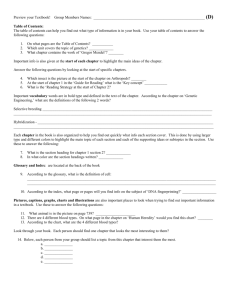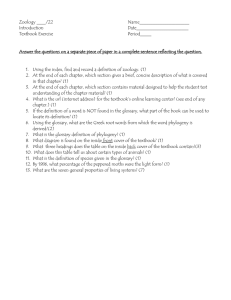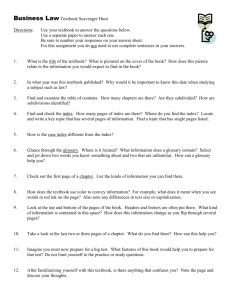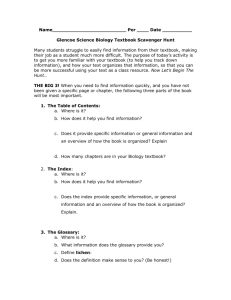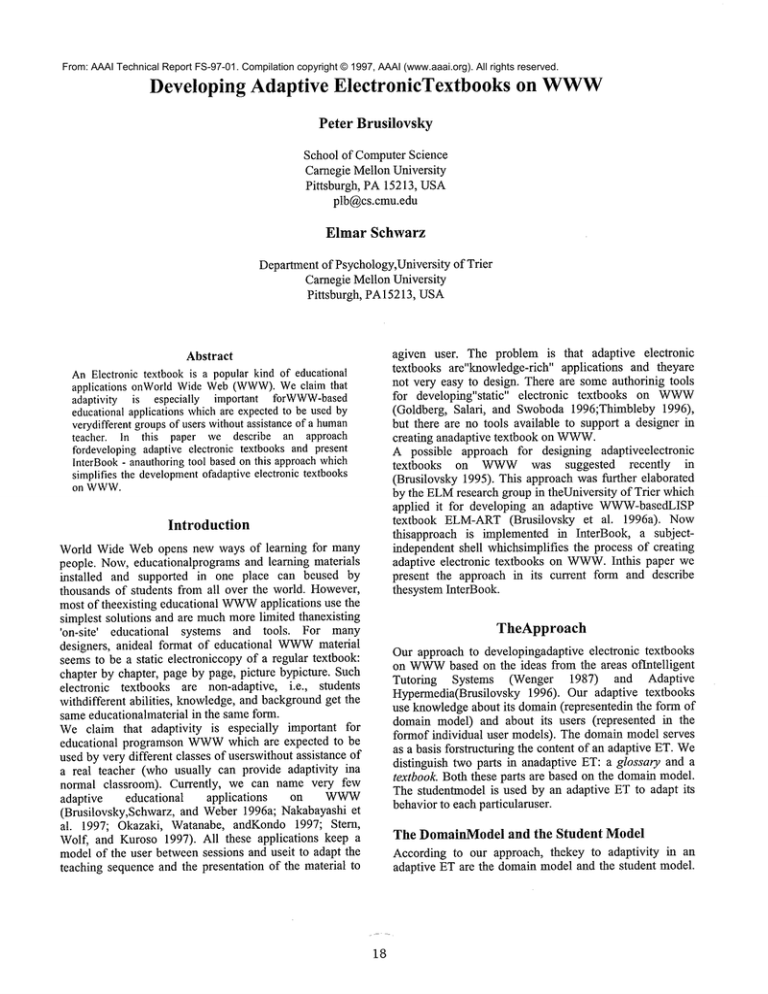
From: AAAI Technical Report FS-97-01. Compilation copyright © 1997, AAAI (www.aaai.org). All rights reserved.
Developing
Adaptive ElectronicTextbooks
on WWW
Peter Brusilovsky
School of ComputerScience
Carnegie Mellon University
Pittsburgh, PA15213, USA
plb@cs.cmu.edu
Elmar Schwarz
Departmentof Psychology,University of Trier
Carnegie Mellon University
Pittsburgh, PA15 213, USA
Abstract
AnElectronic textbook is a popular kind of educational
applications onWorldWide Web(WWW).
Weclaim that
adaptivity is especially important forWWW-based
educationalapplications whichare expectedto be used by
verydifferentgroupsof users withoutassistance of a human
teacher. In this paper we describe an approach
fordevelopingadaptive electronic textbooks and present
InterBook- anauthoringtool basedon this approachwhich
simplifies the development
ofadaptiveelectronic textbooks
on WWW.
Introduction
World Wide Webopens new ways of learning for many
people. Now,educationalprograms and learning materials
installed and supported in one place can beused by
thousands of students from all over the world. However,
most of theexisting educational WWW
applications use the
simplest solutions and are muchmore limited thanexisting
’on-site’
educational systems and tools. For many
designers, anideal fornaat of educational WWW
material
seems to be a static eleetroniccopy of a regular textbook:
chapter by chapter, page by page, picture bypicture. Such
electronic textbooks are non-adaptive, i.e., students
withdifferent abilities, knowledge,and backgroundget the
same educationalmaterial in the same form.
Weclaim that adaptivity is especially important for
educational programson WWW
which are expected to be
used by very different classes of userswithout assistance of
a real teacher (who usually can provide adaptivity ina
normal classroom). Currently, we can name very few
adaptive
educational
applications
on WWW
(Brusilovsky,Schwarz, and Weber 1996a; Nakabayashi et
al. 1997; Okazaki, Watanabe, andKondo 1997; Stern,
Wolf, and Kuroso 1997). All these applications keep
modelof the user between sessions and useit to adapt the
teaching sequence and the presentation of the material to
18
agiven user. The problem is that adaptive electronic
textbooks are"knowledge-rich" applications and theyare
not very easy to design. There are someauthorinig tools
for developing"static"
electronic textbooks on WWNV
(Goldberg, Salari, and Swoboda1996;Thimbleby 1996),
but there are no tools available to support a designer in
creating anadaptive textbook on wv~rw.
A possible approach for designing adaptiveelectronic
textbooks
on WWW
was suggested
recently
in
(Bmsilovsky 1995). This approach was further elaborated
by the ELMresearch group in theUniversity of Trier which
applied it for developing an adaptive WWW-basedLISP
textbook ELM-ART(Brusilovsky et al. 1996a). Now
thisapproach is implemented in InterBook, a subjectindependent shell whichsimplifies the process of creating
adaptive electronic textbooks on W-WVv’.
Inthis paper we
present the approach in its current form and describe
thesystem InterBook.
TheApproach
Our approach to developingadaptive electronic textbooks
on WWW
based on the ideas from the areas of[ntelligent
Tutoring
Systems (Wenger 1987) and Adaptive
Hypermedia(Brusilovsky 1996). Our adaptive textbooks
use knowledgeabout its domain(representedin the form of
domain model) and about its users (represented in the
formof individual user models). The domain model serves
as a basis forstructuring the content of an adaptive ET. We
distinguish two parts in anadaptive ET: a glossary and a
textbook. Both these parts are based on the domainmodel.
The studentmodel is used by an adaptive ET to adapt its
behavior to each particularuser.
The DomainModel and the Student Model
According to our approach, thekey to adaptivity in an
adaptive ET are the domain model and the student model.
The simplest form of domainmodel is just aset of domain
concepts. By concepts we mean elementary pieces of
knowledgeforthe given domain. Depending on the domain
and the application area,concepts can represent bigger
orsmaller pieces of domain knowledge. A more advanced
foml of the domainmodel is a network with nodes
corresponding to domainconcepts and withlinks reflecting
several kinds of relationships
between concepts.
Thisnetworkrepresents the structure of the domaincovered
by a hypermedia system. The domain model provides a
structurefor representation of the student’s knowledgeof
the subject. For eachdomainmodel concept, an individual
student’s knowledgemodel stores somevalue which is an
estimation of thestudent knowledgelevel of this concept.
This type of model (which iscalled an overlay model) is
powerful and flexible: it can measureindependently the
student’s knowledgeof different topics.
TheGlossary
Tile glossary is the central partof the ET. Accordingto our
approach, the glossary is considered as a visualized
(andextemalized) domain network. Each node of the
domainnetworkisrepresented by a node of the hyperspace,
while the links between domainnetworknodes constitute
main paths betweenhyperspace nodes. The structure of the
glossary resembles the pedagogicalstructure of the domain
knowledgeand, vise versa, each glossary entrycorresponds
to one of the domain concepts. The links between domain
modelconcepts constitute
navigation paths between
glossary entries. Thus, the structure of the manual
resembles thepedagogic structure
of the domain
knowledge. In addition to providing adescription of a
concept, each glossary entry provides links to all
booksections which introduce the concept. Itmeans that the
glossary integrates traditional features of an index and
aglossary.
TheIndexed Textbook
A human-written textbookrepresents
human teaching
expertise on howto introduce the domainconceptsto the
learners. It is usually a real textbook represented in
hypermediaform. A textbook is hierarchically structured
intounits of different level: chapters, sections, and
subsections. To makethetextbook "more intelligent" and to
connect it to the glossary, we have tolet the system know
what each unit of the textbook is about. It is done by
indexing of textbook units withdomain model concepts.
For each unit, a list of concepts related with thisunit is
provided (we call this list spectrumof the unit). For each
involved concept, the spectrum of the unit canrepresents
also the role of the concept in the unit. Currently we
supporttwo roles: each concept can be either a outcome
concept or a prerequisite concept. A concept is included in
the spectrum as a outcomeconcept ifsome part of this page
presents the piece of knowledgedesignated by theconcept.
A concept is included in the spectrum as a prerequisite
concept ifa student has to knowthis conceptto understand
19
the content of the page. Indexing is a relatively simple
butpowerful mechanism, because it provides the system
with knowledgeabout the content of its pages: thesystem
knows which concepts are presented on each page and
which conceptshave to be learned before starting to learn
each page. It opens the way forseveral adaptation
tectmiquespresented in the next subsection.
Functionality
Domainmodel-based indexing is arelatively simple but
powerful mechanism, because it provides the systemwith
knowledge about the content of its pages: the system
knows whichconcepts are presented on each page and
which concepts have to be learned before starting to learn
eachpage. It opens the path for several adaptation
techniques presented in thissubsection. All of these
techniques were implemented and tested inInterBook
system(Brusilovsky, Schwarz, and Weber1996b).
AdvancedNavigation
The knowledge about the domain and about the textbook
content is used toserve a well-structured hyperspace. The
system supports sequential andhierarchical links between
section. It generates the table of content whereall entries
are clickable links. In addition, it generates links
betweenthe glossary and the textbook. The concept bar
provides links from eachtextbook unit to corresponding
glossary pages for each involved concept(Figure 1). On the
other hand, fromeach glossary page describing a concept
the systemprovides links to alltextbook units which can be
used to learn this concept (Figure 2). Theselinks are not
stored in an external format but generated on-the-fly by
aspecial module which takes into account the student’s
current state of knowledge represented
by the
studentmodel. This approach is not only reducing page
design time but alsoprovides room for adaptation. In
particular,
our approach supports twoadaptation
techniques: adaptive navigation support and prerequisitebased help.
AdaptiveNavigation Support
Our approach provides many moreopportunities
for
browsing the course materials than traditional
onlinetextbooks. The negative side of it is that there is a
higher risk for thestudent to getlost in this complex
hyperspace. To support the student navigating throughthe
course, the system uses two adaptive hypermedia
techniques (Brusilovsky1996): adaptive annotation and
direct guidance. Direct guidance meansthat the system can
suggest to the student the nextunit to be learned. A possible
way to provide direct guidance with ourapproach is
presented in (Brusilovsky and Schwarz 1997). Adaptive
annotation means that the system uses visual cues (icons,
fonts,colors) to showthe type and the educational state of
each link.
Netscape:l.nterBook User and Author Manual
-~
InterBookU~r and AuthorManual
o3. ~rboo~: 3~rB~o~-~c~’oYdc~,~ao~’,¢
~I
~-J~
: :l c~t~n~
-:-"--I
:
I
F -
I
H~t-
I
I
I
~ To makethe textbook-~"moreintelligent" and to connectit to the
Wi
glossary’-, we haveto let the systemknowwhatabout each section’~ of !~!i! *
~
: the textbook is. It is done by indexing the textbook sections b~:ain ilili
~:ii!
i i model-,concerts’.. For eachunit, a list of conceptsrelated with this
: : p:::-(:e
calllist
of::t}.
For
: involved
concept,
thespectrum
oftheunitcanrepresent
alsotierole
I i of theconcept
m theunit.Currently
we support
tworoles:
each
i::conceptcan be either an ou/z:?.r~,
conceptor a h~.~?~u.:$concept.
I :.A concept is included in tie spectrmn as an outcomeconcep_t~ if some
i part of this page presents the piece of knowledgedesignated by the
:, concept. A conceptis included into the spectrumas a prerequisite
, concept if a student has to knowthis concept to understandthe content
!of the page. Indexing is a relatively simple but powerfulmechanism,
i: becauseit provides tie systemwith knowledgeabout tie content of its
¯ I pages:
the system knowswhichconcepts
arepresented
on eachpage
:; and whichconcepts have to be learned before starting to learn each
:: page. It opensa wayfor several adaptation techi:iques,
J I~
I
II
I
Co~’ti,nue
Teooh me
-
¢wc~,,
r._ ,
~,,~’~
,
modz_l
:::)):
::ii:i.~u
i:~.~:
"-*"~’: !j : --- ii!i: i Oat~-~e:
i::!i
iii! ~ack~ou~a
c~:cepj
: :"
~ ::
outcome
co:~cep_t
!:~i:
~
:I: ~ecu~:~
!:if: -- I I
ii1::~
~ ::
Figure 1. A unit of an adaptive ET prepared and shownwith InterBooksystem. Colored balls (up) and checkmarks(right,
the concept bar)provide adaptive mmotation. Button "Teach me" (bottom) provides directguidance.
Using the student model, it is possible to distinguish
several educationalstates for each unit of ET: the content of
the unit can be knownto thestudent (all outcomeconcepts
are learned or well-learned), ready to belearned (all
prerequisites are learned or well-learned), or not ready to
be learned (some prerequisiteconcepts are not yet learned).
The icon and the font of each link presentedto the student
are computed dynamically from the individual student
model.They always inform the student about the type and
the educational state of the unit behind the link.
InInterBook, a red ball and italic font meannot ready to be
learned, a greenball and bold font mean ready and
recommended, a white ball means learned,no
new
information. A checkmark is added for already visited
units (Figure t). The same way can be used todistinguish
and show several levels of students knowledge of the
conceptsshown on the concept bar. In InterBook, no
annotation means "unknown",small checkmark means
"known" (learningstarted),
medium checkmark means
"learned" and big checkmarkmeans "well-learned" (Figure
1).
Prerequisite-based Help
The system knowledgeabout thecourse material comprises
knowledgeabout what the prerequisite conceptsare for any
unit of the textbook.Often, when students have problems
with understanding some explanation orexample or solving
a problem, the reason is that someprerequisite materialis
not understood well. In that case they can request
prerequisite-basedhelp (using a special button) and, as
answerto help request, the systemgeneratea list of links to
all sections which present some informationabout
background concepts of the current section. This list is
adaptivelysorted according to the student’sknowledge
represented in the student model: more "helpful" sections
are listed first. Here "helpful" meanshowinformative the
section is to learn about the background concepts.
Forexample, the section which presents information about
an unknownbackgroundconcept is more informative than a
section presenting information about a knownconcept. The
section whichpresents information about two unknown
background concepts is moreinformative than a section
presenting information about one concept.
20
__ Netscape:
¯
¯
-
Glossary
’
ALL A B_
C
D E
F
i ~ ~ ~ ~
m
~ ~ ~ ~
_s ~ _qv_-
.
and Concepts
_’mill
-
"
_
----
_
-: -~ Qindex- .
-~Q
- intefacetechnolog/es
-~Ointellige,
ntdi
Qin~tiwe evaluator
__
- _ -I
:-_
~
1
i
I interbook
I
~iinterbook.(with
small
I andB)isthename
for
i Inta’Book-serwd
ET.
I i
This concept is introducedon these pages:
I 3: fnte.rbooks.
fnte?J~%~-se.~ved
eJect#~cte~.L~gks
I
I
I
I
I
:aintarbook
i Knovledge
aboutthisconcept
is required
for:
’:
i
I 4. 3" G~nte~t.
wJhdow
I 4.Yhi~.~h
w.,k~ow
Figure 2. Glossary windowof InterBookshowinga page for "interbook". In addition to a short description of theconcept
"interbook", annotated links to all pages which introduce"interbook" and all pages which require this concept are shown.
InterBookInterface
InterBook uses advanced features of modembrowsers such
as multiplewindowsand frames to provide the student with
useful and powerfulinterface.
Main windows used by
InterBook are the textbook window (Figurel) and the
glossary window(Figure 2).
The Glossary windowis used to view the glossary. The
upper part of the windowis a list of glossary concepts.The
lower part of this windowis used to show the glossary
entry for aconcept. For each concept the system presents
the concept description (ifprovided by the author), the list
of section titles (selected from all available textbooks)
which present theconcept (i.e., whichhave it as an outcome
concept) and the list of sectiontitles which require this
concept (i.e., which have it as a backgroundconcept).
21
Section titles are clickabte links which makes the
corresponding section to be loaded to theTextbook
window.
The Textbook window is the most important window in
InterBook interface.This windowis designed to view the
maincontent of a textbook, section bysection. It is divided
into frames performing different functions. Mainframeof
the Textbook window is theText window. This window
showsa particular section of the textbook whichis called
current section. For a terminal section the Text window
showsthetitlc of the section and the section itself. For a
high-level section the Text windowshows thetitle, the
section preface (if existing) and the full table of content
forthe section (i.e. list of hierarchically structured titles of
itssubsections downto terminal level). Avertical bar to the
right of the Text windowis the Concept bar. It is usedto
show the concepts related with the current section. All
names ofconcepts on the Concept bar are links to the
Glossary. The upper part oflhe Textbook windowhosts the
navigation center and the toolbox. The navigation center
showsthe position of thecurrent section in the textbook: it
lists the titles of all directpredecessors(father, grandfather,
etc.) and all brothers of the currentsection. All namesof the
sections are clickable links. The navigation center serves
for both orientation andnavigation. The toolbox provides a
set of buttons which are used to calladditional windows
(such as content window,search window,andprerequisitewindow) which provides additional
based help
functionality.
Authoring
with InterBook
Authoring an adaptive electronic textbook can be divided
into 5 steps whichare described in detail below (see Figure
3). In brief, an ElectronicTextbook is prepared as
specially structured Wordfile and the task is toconvert this
file into InterBook format. The result of this process is a
file with the Textbook in InterBookformat which can be
served on WWW
by the InterBook system.
Figure 3. Authoring adaptive ETwithInterBook
InterBook recognizes thestructure of the documentthrough
the use of headers. It meansthat thetitles of the highest
level sections should have a pre-defmedtext style"Header
22
1", the titles of its subsections should have a predefmedparagraphstyle "Header2", and so forth.The title of
the textbook should have paragraph style "Title". The
resultof this step will be a properly structured MSWord
file.
The second step in the authoring process theninvolves
concept-based annotation of the Electronic Textbook (ET)
to letinterBook know which concepts stand behind each
section. This knowledge allowsinterBook to help the
reader of the ETin several ways, and the result ofthis step
is an annotated (and structured) MSWordfile.
Anannotation is a piece of text of special style and format
inserted atthe beginning of each section (between the
section header and the firstparagraph). Annotations have
special character style (hidden + shadowed)whichare not
visible in the text windowto the reader of the ET. For each
unit the author provides a set of outcomeand background
concepts. In this way, eachsection is annotated with a set of
prerequisite concepts (or terms whiehexist in other sections
which should be read before the current section),and a set
of outcome concepts (terms which will be assumed known
once the reader has visited the section). Theformatfor the
outcome annotation is: (out: concept-name1, conceptname2,etc.) and the format for the background annotation
is: (pre: concept-namel,concept-name2,
etc.).
Oncethe annotations are complete the file is saved in RTF
format. The RTFtoHTMLprogram with some special
settings is used to convert the ET into HTMLformat.
Then
the .html extension on the file is manually altered to
.interso that it can be recognizedby the Interbooksystem.
Lastly, when the InterBook server starts, it parses all
interbook files inits "Texts" folder (i.e. all files with
extension .inter) and translates itinto the list of section
frames. Each unit frame contains the nameand typeof the
unit, its spectrum, and its position in the original HTML
file. The obtained LISPstructure is used by InterBook to
serve all the available textbooks on WWWproviding
the
advanced navigation and adaptation features.
The
contentwhich is presented to the student is generated onthe-fly using the knowledge about the textbook, the
studentmodel, and HTML
fragments extracted from the
original HTML
fde. Thesefeatures of InterBook are based
on the functionality
of the CommonLispHypermedia
Server (Mallery 1994).
Aswecan see, our tool seriously simplifies the design of
adaptive
ET on WWWforthe authors who use the
approach presented in section 2. It providesfull support in
preparation and serving an ET for the authors who know
onlyhowto use the MSWordtext processor. An advanced
used who have some knowledge
on HTML and
LISPprogramming can use our tool more flexibly. For
example, an author canbypass step 1 and 2 by preparing
the textbook directly in HTMLformat withannotations
provided as specially formatted comments. The author can
also replace
server
response
functions
and
HTMLgenerating functions to implement different
structure and different "lookand feel" of the be requested
by a unique URL. To enable the server torespond to a
(Nakabayashiet al. 1997) as examples of WWW
adaptive
electronic textbooks based on indexing. Weexpectthat the
WWW
will boost the research and development work
onadaptive electronic textbooks.
particular URL, this URLhas to be associated to a
response function implemented in LISP which has
togenerate an HTMLpage on the fly as an adaptive
response. CL-HTTPincludesa set of LISP fimctions for
generating pages.
Acknowledgments
Discussion:Indexing for "MoreIntelligent"
Authoring on WWW
Part of this work was supportedby an Alexander yon
Humboldt-Stifttmg
Fellowship
and James S.
McDonnellFoundation
grant to the first author.
The main idea behind our tool isusing concept-based
indexing to makeconventional educational material more
intelligent and flexible.The idea of indexing is to provide
the information about the content &each unit of
conventional educational material by indexing this unit
withrelated domain concepts. Previously, indexing was
applied in three authoring contexts: CAI context,
hypemlediaauthoringcontext and ITS authoring context.
Indexing was originally suggested in CAI contextby Osin
(1976) who suggested a framework for indexing CAI
frames by a set of topics which itcovers. Suchindexed sets
of frames were not related to any pre-scribedorder of
presentation.
They can be accumulated, stored in
speciallibraries, and re-used by different authors to create
their owncourses. In the multimediafield, a similar idea of
are-usable database of multimedia learning material
indexed by topics andkeywordsis elaborated by Olimpoet
al. (1990).
Later indexing
was applied in hypermedia and
ITSauthoring area. In the hypermedia authoring area, an
idea of indexing waselaborated by Mayes, Kibby and
Watson (1988) in the StrathTutor system. They stressed
additional preference of indexingthe frames of learning
material - the possibility to indicate related pairsof frames
not by tedious glossary linking of pieces of learning
materialtogether,
but dynamically, on the basis of
similarity of corresponded sets of topics. In the ITS
authoringarea, indexing was applied to turn traditional CAI
into a "slightlyintelligent"
ICAl (Elsom-Cook and
O’Malley 1990; Grandbastien
and Gavignet1994;
Vassileva 1992). "Slightly intelligent" ICAI are based on
both the CAIand ITS paradigms.The teaching material is
not generated as in ’orthodox’ ITS, but stored inCA_I-like
frames. However, these frames are indexed with the
concepts froman explicit domain model network, so they
can be selected intelligently. The most recent application
ofindexing on the crossroads of the above directions is
hypermedia-based ITSwhich use indexing technology to
connect the learning material
represented
in a
hypermediaform with the domain knowledge base: SHIVA
(Zeiliger 1993), ITEM/PGandISIS-Tutor (Brusilovsky,
Pesin, and Zyryanov1993).
Indexing shows to be a relatively
cheap and useful
technology for authoring"moreintelligent" hypermediaand
CAIsystems. Weargue that it is therelevant technology for
developing more adaptive and intelligenteducational
applications of WWW.
Currently,we can name only ELMART (Brusilovsky
et al. 1996a) and CALAT
23
References
Brusilovskry, P. 1995. Adaptivelearning with WWW:
The
Moscow
State University Project. In Proceedingsof I’elematics
for Education
and Training Conference, 252-255.
Amsterdam:lOS.
Brusilovsky, P. 1996. Methodsand techniques of adaptive
hypermedia.User Modelingand User-AdaptedInteraction 6(23):87-129.
Brusilovsky, P.; Pesin, L.; and Zyryanov,M.1993. Towardsan
adaptivehypermediacomponentfor an intelligent learning
environment.InProceedingsof 3rd International Conferenceon
Human-Computer Interaction,EWHCI’93, 348-358. Berlin:
Springer-Verlag.
Brusilovsky,P. and Schwarz,E. 1997. User as student: Towards
an adaptiveinterface for advancedWeb-basedapplications. In
Proceedingsof 6thInternational Conferenceon User Modeling,
177-188.Wien:SpringerWerlag.
Brusilovsky, P.; Schwarz,E.; and Weber,G. 1996a. ELM-ART:
An intelligenttutoring
system on World Wide Web. In
Proceedingsof Third InternationalConference on Intelligent
TutoringSystems,ITS-96,261-269.Berlin:SpringerVerlag.
Brusilovsky, P.; Schwarz,E.; and Weber,G. 1996b.A tool for
developingadaptive electronic textbooks on WWW.
In
Proceedings of WebNet’96, WorldConference of the Web
Society, 64-69. SanFrancisco, CA:AACE.
Elsom-Cook,M. T. and O’Malley,C. 1990. ECAL:Bridging the
gap betweenCALandintelligent tutoring systems. Computers
andEducation15 (1):69-81.
Goldberg,M. W.; Salari, S.; and Swoboda,P. 1996. WorldWide
Web- coursetool: An environment for building WWW-based
courses. ComputerNetworksandISDNSystems 28:1219-1231.
Grandbastien,M. and Gavignet, E. 1994. ESCA:Anenvironment
to design andinstantiate learning material. In de Jong, T. and
Sarti, L. (eds.): Design and production of multimedia and
simulation-basedleat71ing matelqal. 31-44. Dordrecht:Kluwer
Academic
Publishers.
Mallery, J. C. 1994. A Common
LISP hypermedia server. In
Proceedingsof theFirst International Conferenceon the WorldWide Web.
Mayes, J. T.; Kibby, M. R.; and Watson, H. 1988. StrathTutor:
Thedevelopmentand evaluation of a learning-by-browsing on the
Macintosh. Computers and Education 12(1):221-229.
Nakabayashi, K.; Maruyama, M.; Kato, Y.; Touhei, H.; and
Fukuhara, Y. 1997.Architecture of an intelligent tutoring system
on the WWW.
In Proceedingsof AI-ED’97, World Conference on
Artificial Intelligence in Education,39-46. Amsterdam:IOS.
Okazaki, Y.; Watanabe, K.; and Kondo, H. 1997. An
Implementation of the WWWBased
ITS for Guiding Differential
Calculations.
In Proceedings of Workshop"Intelligent
Educational Systems on the World Wide Web" at AI-ED’97,
8thWorldConference on ArtificialIntelligence in Education, 1825. Kobe, Japan: ISIR.
Olimpo,G.; Persico, D.; Sarti, L.; and Tavella, M. 1990. Onthe
concept ofdatabase of multimedia learning material. In
Proceedings of WorldConference on Computers and Education,
431-436. Amsterdam:NorthHolland.
Osin, L. 1976. SMITH: Howto produce CAI course without
programming, bztetvlational
Journal on the Man-Machine
Studies 8:207-241.
Stem, M.; Wolf, B. P.; and Kuroso, J. 1997. Intelligence on the
Web?InProceedings of AI-ED’97, 8th World Conference on
Artificial Intelligence inEducation, 490-497. Amsterdam:IOS.
Thimbleby, H. 1996. Systematic web authoring. In Proceedings
of Symposium"The Missing Link: Hypermedia Usability
Research & The Web" Milton Keynes,U.K.
Vassileva, J. 1992. DynamicCAL-coursewaregeneration within
an ITS-shellarchitecture. In Proceedings of 4th International
Conference, ICCAL’92,581-591.Berlin: Springer-Verlag.
Wenger, E. 1987. Artificial
intelligence
and tutoring
systems.Computational approaches to the communication of
knowledge. Los Altos:Morgan Kaufrnann.
Zeiliger, R. 1993. Adaptive testing: contribution of the SHIVA
model. InLeclercq, D. and Bruno, J. (eds.): Item bankqng:
blteractive testingand self-assessment. NATO
ASI Serie F, Vol.
112, 54-65. Berlin:Springer-Verlag.
24

